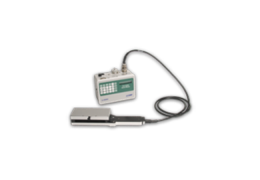Making measurements
When using the scanning head on attached leaves, observe the following three important principles:
- Pull the length encoding cord at the same rate as the sample is being pulled through the scanning head. This is accomplished by holding the length encoding knob against a stationary object (stem, etc.) as the scanning head is drawn over the sample.
- Pull the length encoding cord straight out from (perpendicular to) the front plane of the scanning head (an angle of 11.5 degrees will cause a 2% error).
- Remove the leaf from the scanning head after pulling it through to prevent additional area from being accumulated. The encoding wheel does not distinguish between cord travel into or out of the scanning head. Area information will accumulate when the cord is retracted with the leaf still in the scanning head.
Area measurement of attached leaves
- Move the ON-OFF switch to ON.
- Open the scanning head and position it over a leaf.
- The leaf does not have to be detached from the plant to be measured.
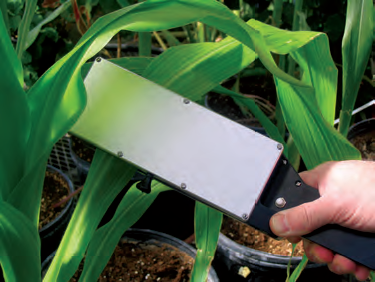
- Close the scanning head over the petiole so that the leaf base is in the scanning head but not between the LED and photodiode (detector) windows.
- For plants such as corn, position the head as near to the leaf base as possible.
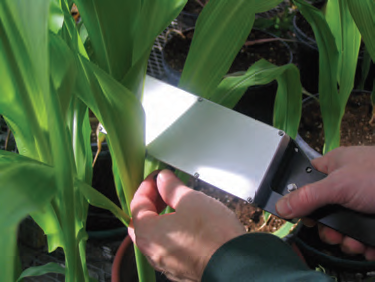
- Draw the length encoding cord to a location where it can be held steady.
- The knob can be held against a stem, or in the case of broadleaf plants, the knob can be held firm by clasping it together with the petiole between the second and third fingers.
- Press the scanning head button once to clear the X register before starting the measurement.
- Draw the closed scanning head over the leaf while the length encoding knob is held stationary.
- Drawing speed need not be constant.
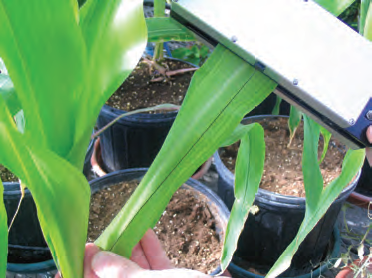
- After the scanning head has passed over the leaf, remove the leaf and let the length encoding cord slowly rewind itself back into the scanning head.
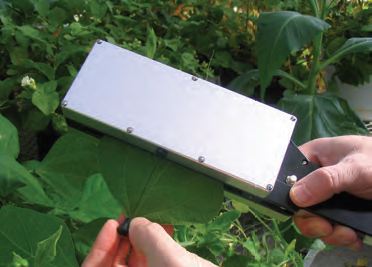
Make sure there is no plant material in the scanning head before allowing the length encoding cord to retract into the head.
Using a transparent sheath
A transparent sheath (user supplied) can be used to measure detached leaves and other objects that require sample support. In order to gain proficiency using a transparent sheath, measure several objects of known area, such as graph paper cutouts.
If detached leaves are to be measured with a sheath, make the measurements as soon as possible after harvesting with the samples kept moist to prevent shrinkage or curling of the leaf margins.
TIP: When measuring samples that are highly irregular or small, such as damaged leaves, leaves with complex margins, roots, thin grasses, etc., accuracy can be improved by changing the ‘3000 Threshold’ (see The Menu key) to a value of 80. This compensates for light lost as it passes through the sheath, and sets the edge counting criteria back to near 50%. Be sure to restore this value to 95 when finished, for normal hand-held measurements.
Measurements with a transparent sheath can be accomplished by following these steps:
- Make sure the sheath is clean and then measure the empty sheath to be certain that known spurious area is measured.
- Place an object in the sheath about 6 cm from one end.
- Open the scanning head and place the sheath in the head with about 4 cm protruding from the left edge and allow the head to close.
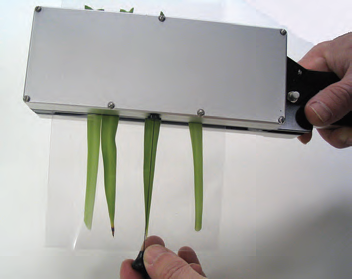
- Grasp the length encoding knob with your left-hand thumb and forefinger and hold it stationary against the sheath.
- Press the scanning head button once to clear the X value on the display.
- Draw the sheath through the scanning head, simultaneously drawing out the length encoding cord.
Hints for various leaf types
Many types of leaves cannot be measured without additional support to guide them through the scanning head. Techniques for several leaf types are discussed below.
- Compound leaves can be measured by either scanning each leaflet, as with the soybean trifoliate, or by enclosing the entire intact leaf in a transparent sheath.
- Tender leaves such as those developed under low light conditions sometimes will not easily slide through the scanning head and may actually tear because of adhesion to the instrument surfaces. In this case a transparent sheath can be placed over the leaf for support and protection.
- Insect damaged leaves which have protruding fragments or naturally dissected leaves having fine lobes usually require support by a transparent sheath.
- Small leaves such as those of alfalfa and small grasses can be removed from the plants and placed in a transparent sheath.
- Elongated, narrow leaves (grasses, etc.) are most accurately measured if they are passed through the scanning head at an angle to the line of LEDs (instead of perpendicular).
In many cases the LI-3050C Transparent Belt Conveyer Accessory will be the method of choice for measuring small objects and detached leaves. The combination of the LI-3050C and LI-3000C provides greater accuracy (±1%) than the LI-3000C alone (±2%).
